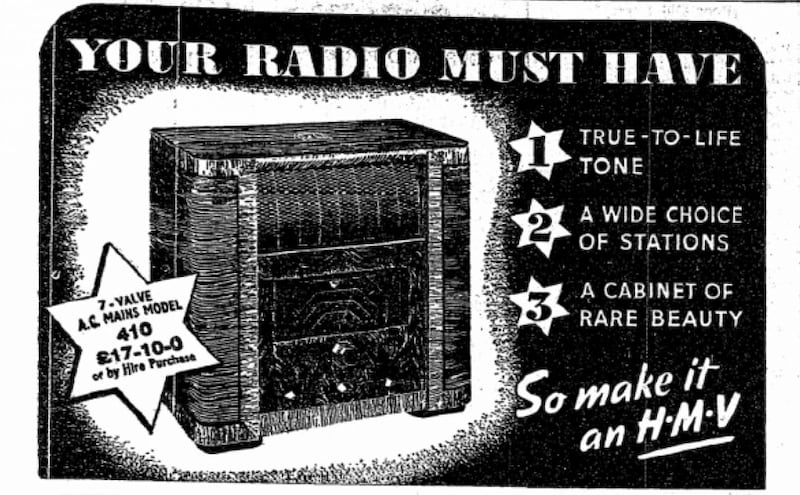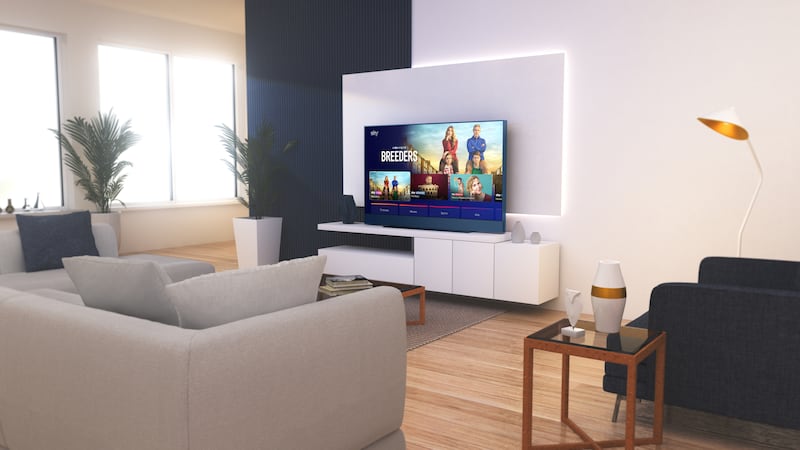Television sets aren’t usually pink – but Sky Glass can be a dusky shade of it. The pay-TV company is billing its first set, available in five “rich hues” with matching stand and remote, as an elegant, unbranded piece of furniture designed to be co-ordinated with home interiors.
It’s a striking approach in a culture in which televisions are more often thought of as functional hardware than beautiful objects. Open the livingroom spreads of any glossy interiors magazine, and the TV is frequently conspicuous by its absence.
Fraser Stirling, global chief product officer for Sky and its US parent company Comcast, remembers his parents’ television growing up in Scotland as a remote-less model with buttons that made the best noise: “It felt like you were switching on a power station.”
Sky is “not trying to out-television anyone”, he says, but it does enjoy being “a little bit contrarian”. Leading manufacturers Samsung and LG, though “brilliant at they do”, compete mainly on audio and display details.
READ MORE
With Sky Glass, on which Sky worked with design agency Map Project Office, the challenge was to “find that balance” between serving as the focal point in somebody’s livingroom and blending into it.
[ Interior trends 2023: Let nature inspire youOpens in new window ]
“It’s a really fascinating problem and we took it very, very seriously,” says Stirling. “You’ll hear a lot of [tech] companies talk about ‘owning the home’. I don’t like that – why is anyone going to ‘own’ my home? It’s my home.”
The frames are made of anodised aluminium, which reflects the light properties of the room in daytime.
“It’s not shiny. It’s not ‘look at me, look at me, I’m a shiny thing’.”
Colour selection, meanwhile, is an evolving science that requires “keeping an eye” on everything from the Milan Furniture Fair, to paint brands’ projected colours of the year.
It is not an accident that three of the launch colours – ocean blue, racing green and anthracite black – are dark, as more people prefer their sets to be dark. Black, the most traditional option, is also the top-seller.
“But folk are buying all the colours,” says Stirling, whose own set is green. A ceramic white set has proven “surprisingly popular”, while customers “really dig” the pink.
Software-related reasons, and pricing ones, will dictate whether Sky Glass does or doesn’t appeal. Central to the pitch, however, is its “no fuss” home-friendliness: the set dispenses with the need for either a satellite dish or a set-top box, while Sky says the six inbuilt Dolby Atmos speakers render a soundbar unnecessary.
The woven acoustic mesh, black by default, can be covered by colour-matched speaker fascias, with patterned limited editions found on “tailoring tables” in Sky stores, where customers are invited to customise their TVs as they would kitchen countertops or bathroom tiles.
“The sandwich you make for yourself is the one that tastes the best, right?”
Thinking about the buying process for a television in this way will seem a new concept to most – if anything, it is closer to the decisions that go into buying a phone. Apple’s penchant for colour makes it the clearest design influence.
Camouflaging instincts only properly subsided in the 1980s, when televisions stopped “pretending to be wood”, ceased to be “brown goods” and became “black goods” alongside the dawn of the video player.
Previous generations have been here before. The first entertainment devices to invade livingrooms were not, of course, televisions but radios. As they proliferated, so too did the sales patter about their aesthetic qualities.
In the 1930s, newspapers would carry advertisements swooning over the “strong handsome oak” or “grained walnut” finishes of table and console radios, with radiograms – combined radios and gramophones – especially likely to be marketed as items of furniture.
Your radio must have three things His Master’s Voice declared in 1938: true-to-life tone, wide choice of stations and “a cabinet of rare beauty”.

Encouraging readers to convert their wireless set into a radiogram, the author of a 1932 article in The Irish Times identified a shift in attitude. Whereas once “a mass of wire, a lot of extraneous gear” enabled us “to show our friends how clever we were to be able to create music from such a mass of apparatus”, this was replaced by an urge to “eliminate muddle”, followed by desire for “not only neatness, but ornamentation”. Ornate radiograms were vehicles for letting furniture fancies “run riot”.
But such observations masked a deeper unease about the technological takeover of the home.
“Anxiety is sort of the way I would characterise it,” says Dr Stephanie Rains, associate professor in the department of media studies at Maynooth University.
“They were really beautiful some of them, these art deco designs. At the same time, they were disguises. They hid the technology, and that then became a more pronounced trend in the early days of television.”
Bringing electric fridges and electric cookers into the kitchen, then a hidden-away space, was a happy event. But amid the soft furnishings of the livingroom, visible technology – with all its connotations of industry – could seem jarring.
[ How to create a book nook – your own cosy corner to read and escapeOpens in new window ]
“In many ways it was because of this lingeringly Victorian idea of the home as a sanctuary in a world that is dirty and dangerous,” says Rains.
The electronics of the television were therefore housed in wood-effect boxes, while in some homes, the set itself retreated to cabinets with folding or sliding doors.
The “telly-box” shape of cathode ray tubes also facilitated adjacent decorative touches in a manner that is now easy to forget – Rains recalls her mother resting a potted plant on top of theirs.
Camouflaging instincts only properly subsided in the 1980s, when televisions stopped “pretending to be wood”, ceased to be “brown goods” and became “black goods” alongside the dawn of the video player.
Unfettered screen size inflation explains why we might love television yet feel ambivalent about the equipment we watch it on, specifically when it’s off
“That was the point when the technology became something to show off,” says Rains.
Nevertheless, in the age of the flat screen, old mid-century tensions may not be completely dead.
“One of the trends we have seen recently is hiding the TV,” says interior design consultant Paula McCarthy of Paula McCarthy Interiors. “People typically don’t want it to be the focal point of their room.”
Television units with sliding doors are back and this time they’re motorised. They’re joined by cabinets with pop-up functions that allow the television to rise up and down.
“And it doesn’t have to pop up, it can pop out,” says McCarthy, citing the covering of wall-mounted TV screens with movable canvas prints.
Some householders, too, make their TV part of a gallery wall, tempering the harshness of an off-black screen with paintings and photographs. Placing the television against a wall painted a dark shade will also help the screen recede into its surroundings.

McCarthy, who headed up advertising sales for Virgin Media Television before setting up her consultancy, believes Sky is “going in the right direction” with its Sky Glass foray.
“People don’t want their TV to just be a big black hole.”
Unfettered screen size inflation – spurred by manufacturers’ push to differentiate the “home cinema” experience from tablets and laptops – explains why we might love television yet feel ambivalent about the equipment we watch it on, specifically when it’s off.
The current generation of Ultra HD sets start at 43-inch (measured diagonally), and salespeople will tell you that the full picture benefits are best appreciated in even larger dimensions.
When Sky Glass – made in 43-inch, 55-inch and 65-inch – went on sale in the Irish market last August, it said its UK experience was that customers were gravitating to larger models.
Sky’s solution to the “cavernous black hole” problem, for those who consider it one, is to suggest customers turn on a feature called Glance – motion technology that prompts the screen to spring into life on a “recommendations” page when you wander into the room. People “unsure” about it during the in-store demonstrations often leave it on, says Stirling.
Though a little heftier than an ultra-slim OLED set, Sky Glass hangs flush against a wall, its stand converting into a wall bracket. Still, more people put it on a unit.
“I think the technical term is a credenza, or, as it’s known in Dumfries, a table.”
In Ikea it’s known as a bench – terminology that also speaks to today’s expansive screens. Ikea recommends a TV bench that is “a bit wider than the TV placed on it”. A TV upgrade without a bench upgrade can result in some less-than-ideal issues of proportion, with modern mega-screens forming odd T-shapes with older, boxier units.
And though it wouldn’t occur to me to bother hiding the TV, I have invested all of €10 in a ribbed plastic “cable hider” from Flying Tiger.
Just as the ability to wall-mount flat screens created a new line of trade for wire-concealing electricians, the arrival of set-top boxes, broadband routers and gaming paraphernalia saw the structure of TV benches adjust to cope with cable spaghetti.
Ikea highlights how its selection will “get things prettied up”, typically by incorporating a discreet gap at the rear through which cables are fed back to power sockets.
While my own television is a modest if room-appropriate 32-inch, the cabinet it sits on – a white, curved-edge “Esme” unit purchased from Made.com before it went into administration – is my most cherished item of furniture. That’s just as well, given how much it occupies my eyeline.
And though it wouldn’t occur to me to bother hiding the TV, I have invested all of €10 in a ribbed plastic “cable hider” from Flying Tiger.
As Sky’s assault on cable clutter hints, further market innovations are on the way. Samsung has a patent for a TV that requires no cables at all – it will instead be accompanied by a wireless power bar, placed behind the screen. Earlier this month in Las Vegas, LG unveiled a 97-inch with the power cord hidden in one stand leg and a transmitter box that can be positioned up to 30 ft away, while a start-up called Displace showcased a totally wireless 55-inch powered by rechargeable batteries. This cable-free future will revolutionise television furniture once again.
Inevitably, we think about technology through the prism of the present. In 1932, The Irish Times posited that householders would soon be able to combine radiograms with televisions, forming wireless sets that “resemble miniature talkie theatres”.
They sound lovely. Anyone for some plush burgundy curtains?



















